11.009 BF185
Luffia ferchaultella
(Stephens, 1850)
Luffia ferchaultella is widespread and locally abundant in southern Britain.
Only the self-fertile wingless female is known, unless it and L. lapidella, which differs only in having winged males and, in Britain, being confined to Cornwall, are the same species.
The cased larvae feed, often gregariously, on lichen on tree trunks and, sometimes, on posts, sloe branches, or rocks.
After the moth has emerged, the empty cases, about 6mm long, remain fully exposed on the trunk into the following spring when they can alert attention to the presence of the smaller occupied cases, often concealed in crevices.
- Description (I.F. Smith):
Larva:
Food: Lichen on tree trunks etc. August to May.
Case: Coated in sand and fragments of lichen and algae, sometimes arranged in bands of colour. Slightly curved cone, widest at the mouth until the last instar, when the mouth becomes constricted. Final instar 5-7mm, late March 3mm.Intermediate instar (late March)
Length of larva: 2.5 mm
Head: Shiny pitchy black, except dark brown clypeus and labrum.
Thorax: Whitish grey ventrally.
Prothorax (T1): Dorsum and sides covered by shiny pitchy black shield with indistinct pale medial line (hardly visible in photographs) and a whitish anterior border.
Mesothorax(T2): Shield as on T1, but narrower, coming to a point at its lowest extremity, where a small dark grey sclerite is positioned to its posterior.
Metathorax(T3): Greyish on dorsum. Laterally, a shiny pitchy black sclerite, depressed at centre, saucer like.
Thoracic legs: Transparent; marked dark brown, especially distal end of femur. Base of legs swollen on T2 and markedly swollen on T3.
Abdomen: Venter translucent yellowish white. Sides yellowish and dorsum grey, both tinted reddish in posterior half of abdomen. Small shiny concolorous dorsal sclerite on A1 and A2.
Spiracles: Concolorous, unobtrusive.
Setae: Transparent colourless, tilted forwards.
Anal plate: Shiny dark brown.
Prolegs: Ventrally small, anal prolegs larger with dark brown base. Not used for locomotion when larva expelled from case. Dark brown crochets.Final instar (early/mid May)
Length of larva: 3.5 mm Head: Shiny pitchy brown, except dark brown clypeus and labrum.
Thorax: Greyish ventrally.
Prothorax (T1): Dorsum and sides covered by pitchy brown shield with grey anterior edge. Divided by a triangular grey mark, widest at posterior.
Mesothorax(T2):Shield as on T1, but narrower, coming to a point at its lowest extremity, where a small dark grey sclerite is positioned to its posterior. Divided by a triangular grey mark, widest at anterior, which does not quite reach the anterior margin of the shield.
Metathorax(T3):Grey dorsally. Laterally, a shiny pitchy brown sclerite, depressed at centre, saucer like.
Thoracic legs: Base of legs swollen on T2 and markedly swollen on T3. Femur and tibia transparent; marked dark brown, especially distal end of femur. Tarsus transparent light brown.
Abdomen: Venter light grey. Dorsum dark grey. Sides brownish dark grey. Very small shiny concolorous dorsal sclerite on A1(largest), A2 and A3(smallest).
Spiracles: Concolorous, unobtrusive.
Setae: Transparent colourless, tilted forwards.
Anal plate: Shiny dark brown.
Prolegs: Ventrally small, anal prolegs larger with dark brown base. Not used for locomotion when larva expelled from case. Dark brown crochets.

 UKMoths
UKMoths 







